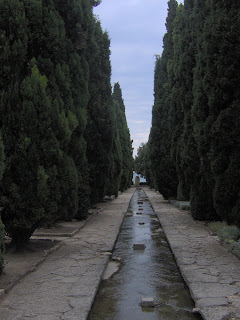Standing high above the city is one of the most ridiculous, Communistastic, gigantic monuments in existence. This hulking amalgamation of concrete is the Creators of the Bulgarian State Monument, also known as the Monument to 1300 Years of Bulgaria. As both names suggest, the monument honors the founders of Bulgaria by commemorating a big milestone in the country’s history. Pretty innocent enough until you get to this fun little nugget of info: The monument is the only one in the world to depict the entire history of a country... something so pretentious, so over the top that it actually becomes awesome.

They accomplish this feat by putting together several different factors. Firstly, there is a huge set of stairs leading up to the monument itself from the center of town. There are (supposedly) 1300 stairs in all leading up the mountain, one for each year of Bulgaria’s history. I didn’t take the time to count each individual stair, but I think it’s safe to say that the figure is at least close to that mark…
When you reach the top of the stairs, you are greeted by some of the most bizarre sculptures I have ever seen. Many of the volunteers affectionately refer to them as “the Transformers.” These robotic-looking piles of concrete set into the bigger hunk of concrete are supposed to be representations of some of Bulgaria’s greatest heroes. The dream team is all there: Tsar Simeon (king of Preslav), Omurtag, Isperix… powerfully staring down at all visitors with all the force of a lego man (the tough one with the frown). Another wall is completely covered in mosaics depicting great moments in Bulgarian history, such as important battles, people building famous landmarks… there’s probably a few hammer-and-sickles and something about the Turks in there as well.

The entire monument is crowned with a gigantic concrete lion, the symbol of Bulgaria, watching over the city and (of course) guarding the entire country. From this spot, on a clear day, one can theoretically see 3 very important Bulgarian places: Pliska (first capital of Bulgaria), Veliki Preslav (second capital), and Madara (home to one of Bulgaria’s most iconic symbols, the rock relief of the Madara horseman – a UNESCO world heritage site and depicted on all Bulgarian coins). The site of the monument is also significant in that, according to legend, the first king of Bulgaria climbed to the spot, looked around at the valley below and declared for the first time that this land would be Bulgaria. I don’t know if there’s any way to verify that legend, but it does actually make for some pretty powerful views at the top.
So that’s another vital Bulgarian experience off my list of things to do in this country. It’s also the cause of my extreme soreness today, but I think it was all worth it, if not for the entertainment value alone.
Until next time…






















